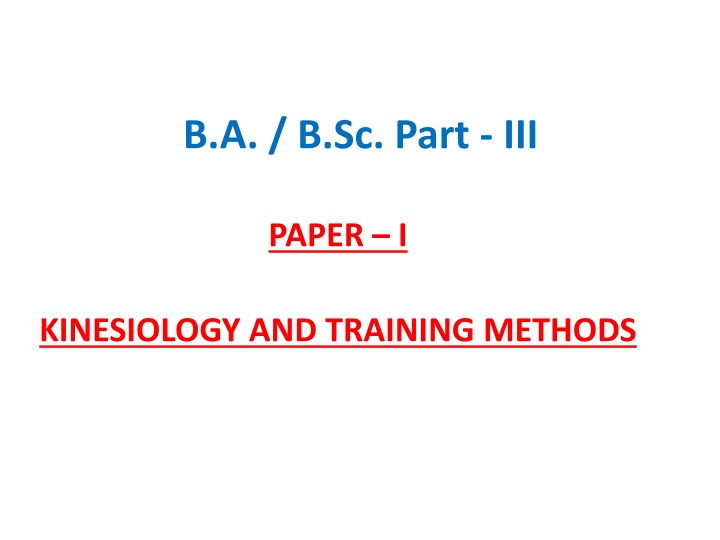
Kinesiology and Training Methods for Human Body Positioning
Explore the fundamental concepts of kinesiology, directional terms, and anatomical position for effective training methods. Learn about dimensions of movement, directional terms, and more to enhance your understanding of human body dynamics.
Uploaded on | 1 Views
Download Presentation

Please find below an Image/Link to download the presentation.
The content on the website is provided AS IS for your information and personal use only. It may not be sold, licensed, or shared on other websites without obtaining consent from the author. If you encounter any issues during the download, it is possible that the publisher has removed the file from their server.
You are allowed to download the files provided on this website for personal or commercial use, subject to the condition that they are used lawfully. All files are the property of their respective owners.
The content on the website is provided AS IS for your information and personal use only. It may not be sold, licensed, or shared on other websites without obtaining consent from the author.
E N D
Presentation Transcript
B.A. / B.Sc. Part - III PAPER I KINESIOLOGY AND TRAINING METHODS
UNIT - I Dimensions, directions & Dimensions, directions & anatomical position of human anatomical position of human body body
Dimensions of Movement 0 Dimension 1 Dimension 2 Dimensions 3 Dimensions 4 Dimensions - - - - - Point. Line. Plane. Cube, Sphere. 3 Dimensions + Time. Note: The movement occurs in all 4 dimensions (time and space).
Directional Terms SUPERIOR Directed upwards or towards the head. INFERIOR - Directed downwards or towards the feet. ANTERIOR Directed towards the front of the body. POSTERIOR Directed towards the back of the body. MEDIAL Nearer the midline of the body. LATERAL Farther from the midline of the body.
Directional Terms PROXIMAL Nearer to the attachment of a Limb to the trunk. DISTAL - Farther from the attachment of the limb to the trunk. SUPERFICIAL Located on or near the surface of the body. DEEP Away from the surface of the body.
THE ANATOMICAL POSITION The Anatomical position is the reference for all the movements. It is also called the standing supine position.
References www.slideshare.net/shimaa2022/planes-axes www.slideshare/TodaysfitnessTrainerttf-planes- axesmovement Biomechanics: A qualitative approach for studying Human Movement, second edition. Ellen Krieghbaum, Katharine Barthels, Macmillan Publishers, London. Textbook of Kinesiology, V.D. Bindal, The Health Science Publisher, New Delhi I London I Panama
